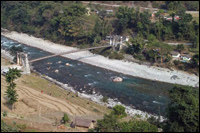 Sikkim’s hydropower pursuits are likely to yield significant results in the ongoing 12th Plan period. Based on interaction with project developers, Sikkim government officials and also reports released by Central Electricity Authority, it is estimated that at least five more projects will be commissioned within the 12th Plan period that concludes on March 31, 2017.Teesta Urja’s 1,200-MW Teesta-III will be the biggest project to commission, followed by Lanco Group’s 500-MW Teesta-VI. Both the projects are progressing well in terms of civil construction and installation of hydro-mechanical and electromechanical equipment. Three other projects likely to turn operational in the ongoing 12th Plan period include Jal Power Corporation’s 120-MW Rangit-IV, Dans Energy’s 96-MW Jorethang Loop and Gati Group’s 51-MW Bhasmey. The early years of the 13th Plan period (FY18 to FY22) could see the commissioning of four smaller projects aggregating around 350 MW.
Sikkim’s hydropower pursuits are likely to yield significant results in the ongoing 12th Plan period. Based on interaction with project developers, Sikkim government officials and also reports released by Central Electricity Authority, it is estimated that at least five more projects will be commissioned within the 12th Plan period that concludes on March 31, 2017.Teesta Urja’s 1,200-MW Teesta-III will be the biggest project to commission, followed by Lanco Group’s 500-MW Teesta-VI. Both the projects are progressing well in terms of civil construction and installation of hydro-mechanical and electromechanical equipment. Three other projects likely to turn operational in the ongoing 12th Plan period include Jal Power Corporation’s 120-MW Rangit-IV, Dans Energy’s 96-MW Jorethang Loop and Gati Group’s 51-MW Bhasmey. The early years of the 13th Plan period (FY18 to FY22) could see the commissioning of four smaller projects aggregating around 350 MW.
|
HEPS UNDER CONSTRUCTION*
|
|||
|
Developer
|
Project
|
MW
|
|
| Teesta Urja Ltd | Teesta-III | 1,200 | |
| Lanco | Teesta-VI | 500 | |
| Dans Energy | Jorethang Loop | 96 | |
| Gati Infrastructure | Bhasmey | 51 | |
| Shiga Energy | Tashding | 97 | |
| Sneha Kinetic Energy | Dikchu | 96 | |
| Sikkim Hydro Power | Rangit-II | 66 | |
| * Partial list | |||
The 1,200-MW Teesta-III will define a clear shift in paradigm for Sikkim. It will not only be the state’s largest hydropower plant, and also amongst India’s largest operational ones, but will be Sikkim’s biggest business asset across all sectors. With the state government holding 26 per cent equity, it will also be a solid validation to the state’s PPP philosophy.
Some analysts feel that once Teesta-III and Teesta-VI get into commercial operation, the state’s economy will improve significantly along with concomitant uplift of Sikkim’s socio-economic levels. This could also result in an attitudinal change, quelling to some extent the reservations that the local population has had against hydropower schemes. Hydropower then could become, as earlier indicated, the very economic backbone of the midget state.
|
HEPS WHERE CONSTRUCTION YET TO START*
|
|||
|
Developer
|
Project
|
MW
|
|
| Himalayan Green Energy | Teesta-I | 280 | |
| Him Urja Pvt. Ltd | Teesta-II | 330 | |
| NHPC | Teesta-IV | 520 | |
| Himagiri Hydro | Pannan | 300 | |
| Gati Infrastructure | Sada-Mangder | 71 | |
| Lachung Power Pvt. Ltd | Lachung | 99 | |
| TT Energy | Ting Ting | 99 | |
| * Partial list | |||
Considering only large hydropower schemes, those with installed capacity exceeding 25 MW, Sikkim has an assessed hydropower potential of 4,248 MW. Currently, 13 per cent of this has translated into installed capacity and by FY17; this would rise to 60 per cent. Sikkim, even today, is very comfortably placed with respect to its power scenario. Power shortages abruptly became history when NHPC commissioned the Rangit project and more so, Teesta-V. According to statistics released by CEA, Sikkim, in FY13, had a total energy requirement of a mere 409 million kwh that was fully met.
Once Teesta-III and Teesta-VI are commissioned, Sikkim will have access to an equivalent of 204 mw of installed capacity (12 per cent of the total installed capacity), which is in addition to the current 100 mw (Sikkim’s own generation plants plus the state’s share in NHPC’s Rangit and Teesta-V projects). Access to 300 MW of hydropower capacity should mean generation of around 1,500 million kwh. This should clearly imply energy security to Sikkim for the foreseeable future. Sikkim could also set a precedent for other hydro-rich north and northeastern states where hydropower potential is much higher and much of it untapped.
|
INSTALLED CAPACITY
|
||
|
Developer
|
MW
|
|
| State Government | 37 | |
| Central Government | 570 | |
| Private Sector | 99 | |
| Total | 706 | |
Sikkim, as it is well known, has the distinction of being the only Indian state that shares a boundary with only one other state. Every other state in India has a boundary with at least two Indian states. This distinction however is only academic, with Sikkim securing it by chance. However, being home to a private hydropower project—an achievement so far seen only in developed states—is a laudable distinction for which the midget state has put in gigantic effort.











